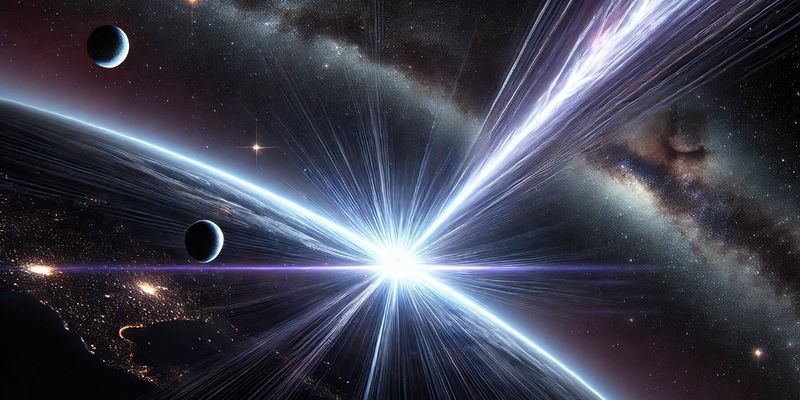In October 2022, an extraordinary event lit up the universe—one that was so intense it outshone anything humanity has ever witnessed. This wasn’t just another astronomical occurrence; it was the “BOAT,” the Brightest of All Time gamma-ray burst officially designated as GRB 221009A, a cosmic flash so powerful that it overwhelmed gamma-ray detectors across the globe. But what does this mean for us, and could such an event pose a threat to our planet?
The BOAT: A Cosmic Firework Like No Other

The Hubble Space Telescope captured the infrared afterglow (circled) of the gamma-ray burst known as GRB 221009A and its host galaxy. This composite incorporates images taken Nov. 8 and Dec. 4, 2022, about one and two months after the eruption. The afterglow may remain detectable for several years. Credit: NASA, ESA, CSA, STScI, A. Levan (Radboud University); Image Processing: Gladys Kober
Gamma-ray bursts (GRBs) are some of the most energetic events in the universe. They’re like cosmic fireworks but on an almost unimaginable scale. The BOAT burst, however, took things to a whole new level. Lasting a full 10 minutes—unprecedented for a GRB—and remaining detectable for 10 hours afterward, this event unleashed more energy in mere seconds than our sun will emit over its entire 9-billion-year lifespan. That’s right—billions of years of sunlight crammed into seconds.
What made this burst even more remarkable was its proximity. Located in the Sagitta constellation, it was just 2 billion light-years away—a stone’s throw in cosmic terms. To put this in perspective, a burst of this brightness so close to Earth is estimated to be a once-in-10,000-year event. The last time something like this occurred, humans were just learning how to farm.
The Mystery Behind the BOAT

The brightest gamma-ray burst ever seen as observed by the Swift X-Ray Telescope around an hour after it erupted. (Image credit: NASA/Swift/A. Beardmore (University of Leicester))
So, what caused such a massive explosion? Gamma-ray bursts typically fall into two categories: short bursts from neutron star collisions and long bursts from massive star collapses. The BOAT, with its extended duration, clearly belonged to the latter. However, this event was 70 times more intense than any other gamma-ray burst on record. Initially, scientists speculated it must have come from the supernova of an unusually massive star. But here’s where things get puzzling—the supernova that followed the BOAT was shockingly ordinary.
The James Webb Space Telescope, the latest marvel in space observation, pointed its instruments at the BOAT and found that the supernova was just average. This contradiction—an average supernova paired with a record-breaking gamma-ray burst—left scientists scratching their heads.
One hypothesis is that the BOAT’s extraordinary brightness was due to Earth’s position relative to the jet of particles the burst emitted. Imagine a flashlight in the dark, its light spreading out and illuminating a path. Now, imagine that light concentrated into a laser beam—less spread out but much more intense. If Earth happened to be directly in the path of this “cosmic laser,” it would register as far brighter than a burst aimed elsewhere, even if the total energy released wasn’t exceptionally high.
Cosmic Consequences: Earth’s Atmosphere Takes a Hit
The implications of the BOAT didn’t stop at its sheer intensity. The gamma rays from this event were so powerful that they momentarily disrupted Earth’s ionosphere, the layer of our atmosphere teeming with electrically charged particles. Sitting just 50 to 1,000 kilometers above us, this layer was pushed down by the BOAT, akin to the effects of a massive solar flare. If a burst 2 billion light-years away can alter our atmosphere, what might happen if one were closer?
The BOAT also raised questions about our understanding of cosmic particles. The Large High Altitude Air Shower Observatory (LHAASO) in China recorded tens of thousands of photons from the event, far more than any other GRB. These findings challenge current models of particle physics, suggesting that our understanding of how gamma rays travel across the universe might be incomplete. Could this event point to new, undiscovered particles like axions, which some scientists theorize could be linked to dark matter?
What This Means for Our Understanding of the Universe
The BOAT event is more than just a record-breaking gamma-ray burst; it’s a puzzle piece in the larger mystery of how the universe works. It challenges our understanding of star formation, particle physics, and the origins of the elements that make up everything around us. The findings from the BOAT suggest that there might be unknown processes at play, ones that could require a revision of the Standard Model of particle physics—a model that has been the bedrock of our understanding for decades.
As scientists continue to study this event, one thing is clear: our universe still holds many secrets. Whether the BOAT is a rare fluke or a sign of something more significant, it serves as a reminder of how much we still have to learn about the cosmos. And while gamma-ray bursts like the BOAT might not pose an immediate threat to humanity, they do remind us of the vast, powerful forces at work in the universe—forces that could, under the right circumstances, have a profound impact on our planet.




![Read more about the article [Funding alert] Cashify raises $90M in Series E round led by NewQuest, Prosus](https://blog.digitalsevaa.com/wp-content/uploads/2022/06/cashify-final-1655912399689-300x150.png)





![Read more about the article [Funding alert] AI-based Haber raises $20M in Series B round led by Ascent Capital](https://blog.digitalsevaa.com/wp-content/uploads/2021/11/NewCopy2-1637661368202-300x150.jpg)